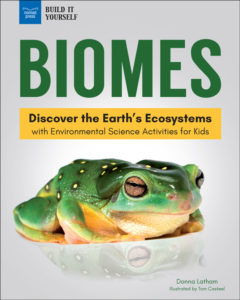“Environmental Science Activities for Kids”
We can all agree that Earth is a pretty amazing planet. We’ve got oceans, rainforests, icebergs, and a huge range of diverse species living all over the place!
Earth is amazing, and it’s also enormous. It can be easy to forget and hard to imagine just how much area there is and how many organisms share it. One way that makes it easier is to think of the planet as a whole system and imagine it as being sectioned into different biomes. That’s what I did when I set out to write a book about what it’s like to live on Planet Earth. By taking a tour of the earth’s different biomes, we can see how interconnected all species actually are and how important it is to take of the environment where you live—because whatever happens to the land, water, and air where you are will have repercussions elsewhere in the world.
In Biomes: Discover the Earth’s Ecosystems with Environmental Science Activities for Kids, I focused on nine biomes: deciduous forests, coniferous forests, tropical rainforests, deserts, temperate grasslands, tropical savannas, tundra, mountains, and oceans. Each one had an entire ecosystem to discover and explore, along with distinct species that had adapted specifically to their environment.
Inviting children along the journey is especially important. Climate change is no longer a slow-moving, far-away issue. Intense storms, rising sea levels, and altered seasons are all readily apparent in ways they didn’t use to be, and children are noticing and asking what they can do to be of service to the planet and help keep it healthy.
So, fasten your helmet as we get ready to embark on a bumpy ride around the world on a tour of the nine biomes! Our first stop is some super cool projects designed to get kids thinking about the environment and their role in its care.
MAKE RECYCLED PAPER
This activity is pretty messy! Be sure to do it outside if possible! You can use your homemade paper to take notes or send letters to friends about your biome discoveries.
Caution: Have an adult help with the blender.
Rip scrap paper into teeny pieces. Place about 1/2 cup of it into a blender. Pour about 2 cups of hot water over the paper. Repeat this process until the blender is halfway full. Cover the blender and set it at a low speed. Mix the paper and water until it reaches a pulpy consistency. If the blender gets sluggish, add a bit more water.
Carefully take the pulp outside. Spread newspaper on a flat surface, and place a towel or rag over it. Set it aside for a moment.
Place a window screen in a pan or on a baking sheet. Pour the pulp over the window screen. Wiggle the screen back and forth until the pulp coats it. Gently lift the screen from the pan or sheet, and allow any excess pulp to drip off.
Set the screen on top of the towel and newspaper. Keep the screen’s pulpy side up. Layer a second towel or rag and more newspaper on top of the screen, creating a sandwich. Use a rolling pin or other tool to press on the sandwich from one end to another until you’ve wrung out all the water.
Spread out a third towel or rag in a warm, dry spot, and carefully place the sandwich on top of it. Allow it to dry for 24 hours. If you live in a humid place, it will probably require more time.
When the paper is completely dry, peel the newspaper and towels away. You’ve got homemade paper!
Think About It:
- How might this method of recycling paper into new paper work for large amounts of paper?
- Could a factory use this process?
- What are some ways companies could change this process so they could work with recycled paper from an entire school?
SALT AND SEED GERMINATION
During periods of drought, soil becomes salty. How does salt concentration in soil impact seed germination? Sprout radish seeds to find out!
Use three plastic deli tubs of the same size. Individually label the tubs, each with a different solution identifier: Solution 1: 1 Teaspoon; Solution 2: 2 Teaspoons; Solution 3: 3 Teaspoons.
Place a piece of paper towel or coffee filter at the bottom of each container. Sprinkle quick-sprouting radish seeds over each piece. Label three plastic cups to match the solution identifiers of each deli tub.
Prepare the solutions. Pour 1 cup of distilled water into each plastic cup. In the Solution 1 cup, add 1 teaspoon of salt. In the Solution 2 cup, add 2 teaspoons. In the Solution 3 cup, add 3 teaspoons. Stir to thoroughly dissolve the salt.
Use an eyedropper to add a small amount of each solution to its corresponding container. Make sure you completely wet each paper towel or coffee filter, but don’t drench it. Cover each container with a piece of clingwrap.
Predict what will happen over a two-week period as you tend the seeds. How will different salt solutions impact seed germination? How will the solutions affect seedlings as they begin to grow?
Place the containers in the same location, where they can receive sunlight undisturbed. Monitor the seeds each day. Write down your observations. Add more solution to each corresponding plant. After two weeks, assess and analyze your results. What are your findings about soil content’s impact on germination and growth?
Think About It:
- What do your conclusions mean for large-scale agriculture?
- What happens when entire farms have soil that becomes too salty?
TEST YOUR AIR QUALITY
Arctic haze is a certain kind of polar air mass. Chock-full of chemical pollutants from Canada, Eurasia, and the United States, this reddish-brown smog sometimes hangs over Alaska, creating poor air quality. What’s the air quality like where you live? Conduct this test to find out.
Choose four separate areas, both indoors and outdoors, to test the air. Indoors, you might select your kitchen, and outdoors, target a bush or shrub.
Label one index card for each location. Your labels should match those in your science journal. Use a craft stick to spread petroleum jelly over the cards. Leave each card in a safe spot in its target area. Wait 8 hours.
To collect data, visit each location and gather its card. Use a magnifying glass to study each sample. Do you observe any particles? What color are they? Can you identify what they are? Record your findings in a notebook.
While you’re at each location, use your senses to take in your surroundings. In your journal, write your observations of the area on the correct page. Can you smell anything? Does the air feel dusty or damp? Do you see blowing sand or plant parts? Is there cigarette smoke, industrial emissions, or road construction that are affecting air quality?
Place each sample in a row. Use the magnifying glass to compare and contrast each card. Which sample is the cleanest? The dirtiest? What conclusions can you draw about the air quality?
Think About It:
- Saharan sunsets occur when gigantic dust clouds from Africa’s Sahara Desert travel thousands of miles across the globe. These produce hazy skies, hotter temperatures, allergies—and beautiful sunsets.
DISCUSSION QUESTIONS
- What type of biome do you live in?
- How does Earth sustain life?
- How are food chains essential to life on Earth?
- How are living things adapted for life in the coniferous forest?
- Why are tropical rainforests called “the lungs of the planet?”
- What changes will occur if the desert continues to be Earth’s fastest growing biome?
- How are grasses and hooved animals adapted to thrive in wide-open spaces?
- What happens when ecosystems change?
- In the interconnected web of life, how do warming temperatures in the Arctic impact the planet?
- What makes mountains different from other biomes?
- How does ocean depth impact biodiversity?
- What have you discovered about Earth’s vast interconnections?
More classroom resources can be found at https://nomadpress.net/wordpress/wp-content/uploads/2014/04/Biomes-Classroom-Guide.pdf.
Biomes: Discover the Earth’s Ecosystems with Environmental Science Activities for Kids
Author: Donna Lathan
Illustrator: Tom Casteel
Published March 5th, 2019 by Nomad Press
About the Book: What’s the difference between a desert and a rain forest? A tundra and a coniferous forest? These are all examples of biomes, and they are all home to plants and animals that are uniquely adapted to live in those environments!
In Biomes: Discover the Earth’s Ecosystems with Science Activities for Kids, middle school kids journey across the planet and visit the world’s nine terrestrial and aquatic biomes to learn about the distinctive climates, geologies, resources, and organisms that can be found there. Kids will wander through forests, sizzle in deserts, shiver in the tundra, slog through marshy waters, and plunge beneath the seas to explore coral reefs. Along the way, readers will encounter the flora and fauna adapted for survival in each unique climate zone. They’ll learn about gnarly krumholz trees, bioluminescent sea creatures, camouflage, carnivorous plants, and blubbery marine critters.
The health and wellbeing of the world’s biomes are an essential part of the balance of the planet as a whole. Biomes and their inhabitants around the world are being threatened by climate change and human behavior. In Biomes, kids will learn how to take steps toward positive change and keep the environment healthy and functioning in a way that best supports sustainable life on Earth!
Biomes includes hands-on STEM activities and critical thinking exercises to encourage readers to consider threats to the environment and figure out ways to be part of the solution. Fun facts, links to online primary sources and other supplemental material, and essential questions take readers on an exploration of the biomes of Earth.
About the Author: Donna Latham is an award-winning author and playwright. She is the author of Amazing Biome Projects You Can Build Yourself, Backyard Biology Investigate Habitats Outside Your Door With 25 Projects, Deciduous, Forests, Deserts, Garbage Investigate What Happens When You Throw It Out With 25 Projects, Norah Jones, Oceans, Respiration and Photosynthesis, Savannas and Grasslands, and Tundra. She is a member of the Society of Children’s Book Writers and Illustrators and the Society of Midland Authors. She lives in Batavia, Illinois. Website: donnalatham.com
Thank you so much for this guest post about our amazing Earth and how it works!



1 thought on “Author Guest Post: “Environmental Science Activities for Kids” by Donna Latham, Author of Biomes: Discover the Earth’s Ecosystems with Environmental Science Activities for Kids”